 |
||
|
||
| ||
TABLE OF CONTENTS
Summer is already over, it has been marked by the GeForce 7800 series. Indeed, NVIDIA's flagship (GeForce 7800GTX) was launched at the end of June, its junior brother appeared nearly two months after - 7800GT, I already wrote about this card. Our subject today is the GeForce 7800 GTX. The joy of the new announcement was that it was made not only on paper. These cards appeared on the shelves right after the official celebrations dedicated to the launch of the fastest accelerator. Moreover, despite the summer time and the consequent traditional recession of sales during that period, these very expensive cards were actively sold. However, there were so many cards manufactured (like an avalanche in response to the deficit of the previous 6800 Ultra) that the prices started crawling down. Though the official recommended retail price is still $549, in America you can come across 7800 GTX cards below $500. Of course, the prices on the Russian market are more inert, but even here you may find reasonable prices ($540-$550), ignoring super-impudent retailers who offer such cards at $650-$660. The Canadian company is already suffering losses, even though its representatives would always reply to all questions that there were no reasons to launch their answer in summer, that only the autumn would bring sales: according to independent experts from Mercury Research, NVIDIA currently owns 73% of the Hi-End accelerators market. ATI was forced to make an unprecedented move and drop its prices for top accelerators: the X850XT PE went down from $549 to $349! It will hardly help though - the 7800GT is already out, even more expensive, than the most powerful accelerator from ATI, it's still a tad faster and based on higher technology. So the only way out for NVIDIA's competitor now is to launch a worthy product, but it will be hard in the light of the dropped prices for the 7800 GTX. Let's get back to the 7800 GTX. I have already reviewed several cards on this GPU, nothing much to write about - for now all partners sell reference cards, ordered by NVIDIA and manufactured by Leadtek (Foxconn). Today we shall examine another reference card from ASUS and the second similar representative, which cooling system is upgraded and which frequencies are raised to 486/1350 MHz. Thus, ASUS Extreme N7800GTX TOP has become nearly the most powerful card for today, even among the 7800 GTX accelerators! Here are the videos, which briefly illustrate the new product.
Of course, the increased frequencies meant additional efforts from ASUS engineers: in order to guarantee operation at these frequencies (+56 MHz on the core and +75 (150) MHz on memory), such cards should be tested and selected. It increases the primary costs, not to mention that the company buys famous coolers from Arctic Cooling for these video cards. So we cannot expect low prices for the ASUS Extreme N7800GTX TOP. I guess they will be more expensive by $50-$60 than the regular GeForce 7800 GTX. But if we take into account that such a cooler has a similar retail price ($45-$50), such an overhead looks appropriate. Let's examine the cards themselves.
Video Cards
I guess there is no reason to comment on the cards, they are copies of the reference card and everything I could say about them can be found in our previous articles (the list is at the end of the article). It should be mentioned that the 7800 GTX is equipped with a couple of DVI jacks and contacts for a SLI bridge.
In conclusion of the examination we should note that the card is equipped with a VIVO codec (VideoIn,VideoOut). That is this product may be used by amateurs to capture analog video and record it in digital form.
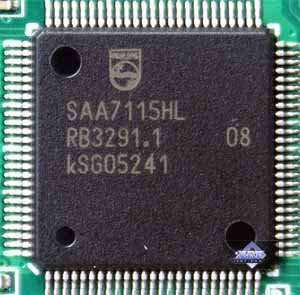
Bundle
Box.
Installation and DriversTestbed configurations:
This picture refers to the ASUS Extreme N7800 GTX TOP 256MB.
 The latest beta version of RivaTuner 15.7 is getting more and more features before the release. It now allows to monitor the card's temperature (Ambient) and cooler's rotational speed (if it's a reference model or if it's equipped with the same 4-pin connector). As I have already mentioned above, the cooler in the ASUS Extreme N7800 GTX TOP 256MB does not have such a connector (just a 2-pin one), that's why the monitoring above does not show correct values of the rotational speed. Now what concerns the temperature. Despite the heavily increased operating frequencies, the cooler is evidently very efficient - the core temperature does not exceed 70° even under the heaviest load. The only thing that troubles me is the hot heatsink on the voltage regulators. The reference cooler takes care of it, no matter how well it does it job. Even if blowing hot air (from GPU) is not a good way of cooling. But in this case this heatsink is covered by the plastic housing of a cooler, which limits air access. Well, we'll be looking forward to comments. Perhaps I'm being too cautious, while the designers checked everything and consider that elements of the power supply unit are not that hot. Overclocking. ROP/Shader units can operate only at 432, 459, 486, 513 MHz (potentially even higher, but there will hardly be such chips). Only the geometry unit allows to control is operating frequency continuously. We managed to overclock this video card to 513/513/553 MHz (core) retaining the operating stability. Maximum memory limit is 1400 MHz. SLI AA 16xBefore the traditional performance tests, let's see what the new AA mode in SLI mode provides in practice, considering that we are promised a super 16x mode! The quality must be above praise! I shall not tire you with theoretical materials and publish a table with screenshots so that you could see everything with your own eyes. We used only those applications that are sure to change their operating mode depending on forced AA in the driver. By the way, not all applications allow this. To be more exact, the driver does not enable the forced mode, if a game does not allow it. In particular, 3DMark05 runs only with AA, which can be selected in its options. It's useless to force AA in NVIDIA's drivers for this package. But this AA mode is supported by ATI cards, if it's disabled in 3Dmark05 and enabled only in the driver.
In my opinion, we don't need a higher AA mode now that TAA can smooth semitransparent textures in MSAA 4x mode. Especially when you see how VORACIOUS this SLI AA 16x mode is. Of course, you should take into account that this mode is not fine-tuned yet. That's why performance may drop not so catastrophically in future... As for now, the AA 16x mode utterly defeats even such a monster as the GeForce 7800 GTX SLI.
Test results: performance comparisonWe used the following test applications:
I'll comment only on the ASUS Extreme N7800 GTX TOP 256MB, as we have reviewed performance of the regular 7800 GTX cards many times. There is no point in repeating them. Comments on the AA 16x performance results are also unnecessary, it's quite clear that the performance drop is capital! Game tests that heavily load vertex shaders, mixed pixel shaders 1.1 and 2.0, active multitexturing.FarCry, Research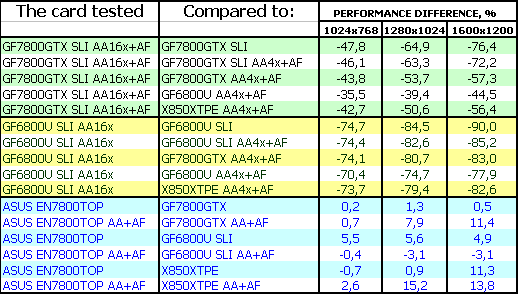 ASUS Extreme N7800 GTX TOP 256MB also did well, it goes up on a par with the 6800 Ultra SLI, even though the latter is obviously more expensive. It outperforms the regular 7800 GTX by up to 11%. Game tests that heavily load vertex shaders, pixel shaders 2.0, active multitexturing.F.E.A.R. (MP beta)
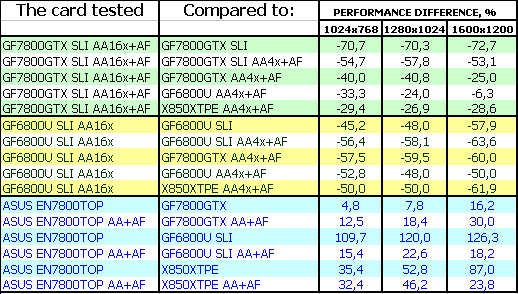 I'll tell you right away that all SLI cards act VERY strangely in this test with Drivers 77.77: they demonstrate very low performance without the AA+AF load. The problem obviously lies in the driver, which doesn't recognize this demo. So there will be no comments about the advantage over SLI - that's obviously a mistake. I guess it's the fault of the Soft Shadow mode, because everything falls into place without it. You can see it right away: as soon as the Soft Shadows mode is enabled, the horizontal line that divides working areas of two SLI accelerators immediately goes down. The second accelerator is evidently nearly idle. What concerns the ASUS Extreme N7800 GTX TOP 256MB - it's superb! It breaks far away from its competitors! It does it in the heaviest game - a potential hit. Splinter Cell Chaos Theory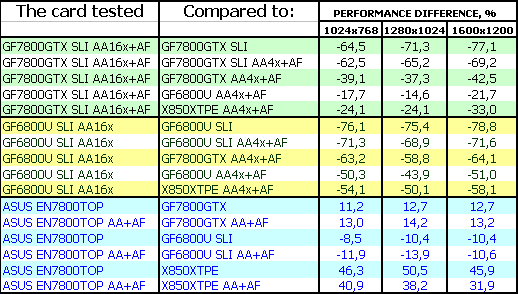 The load here is also very high, especially to shader units. That's the only reason the 6800 Ultra SLI has taken up the lead. But you can just as well ignore it, because the price for this tandem is still higher than for the most expensive 7800 GTX card. In other respects the ASUS Extreme N7800 GTX TOP 256MB does an excellent job!
Half-Life2: ixbt01 demo
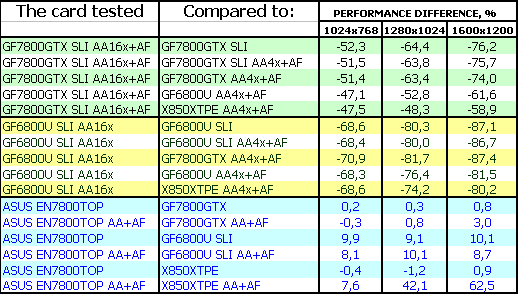 This test is limited heavily by a processor even with AA+AF, so it's difficult to evaluate cards objectively here. We can only see that the ASUS Extreme N7800 GTX TOP 256MB offers excellent gameplay under the heaviest load even in high resolutions.
Game tests that heavily load pixel pipelines with texturing, active operations of the stencil buffer and shader unitsDOOM III High mode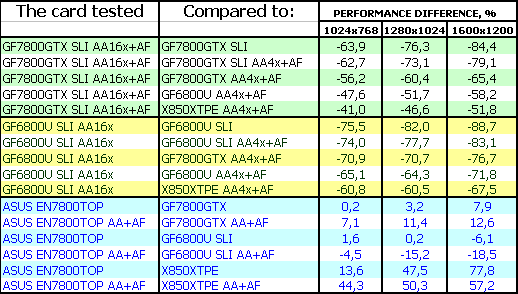 Chronicles of Riddick, demo 44
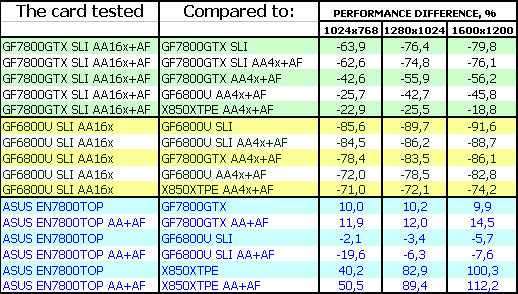 Well, this group of traditionally advantageous games for NVIDIA demonstrates that the ASUS Extreme N7800 GTX TOP 256MB is a leader among single-chip accelerators (that is without SLI). Even though the 6800 Ultra SLI is outperformed only insignificantly, we can score a victory to the card from ASUS.
Synthetic tests that heavily load shader units3DMark05: MARKS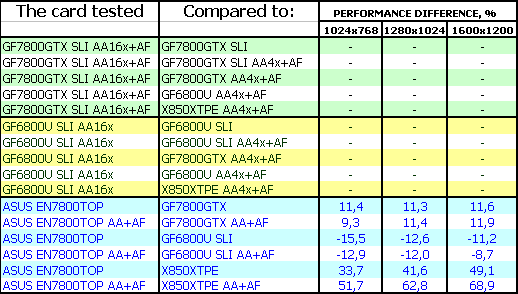 This situation is similar to what we have seen in F.E.A.R. ASUS Extreme N7800 GTX TOP 256MB is beyond competition! (of course, if we don't take into account the 6800 Ultra SLI).
ConclusionsASUS Extreme N7800 GTX 256MB is an ordinary product based on the standard GeForce 7800 GTX. There is nothing special about it. It's not manufactured by ASUSTeK. Yep, it's a reference card distributed by NVIDIA among its partners. So if the price is raised too high, there is no reason to chase the brand, you will get the same features from any other NVIDIA's partner (but for a lower price). It has an advantage - a good bundle with a bonus of a leather CD album. ASUS Extreme N7800 GTX TOP 256MB is also based on a reference card, but the selection guarantees it to run at higher frequencies. Thus this card is an absolute leader in performance and wins our attention. Add a very efficient and quiet cooling system, which drives the heat away from a system unit. It's the nicest looking accelerator I've ever reviewed. Of course, the price will play a pivotal role. I hope retailers won't raise it so that it would be more reasonable to buy a regular card with moneyback plus an Arctic Cooling device and to try and overclock the 7800GTX to the same frequencies as in the product from ASUS. Both cards demonstrated excellent quality in 2D at 1600x1200@100Hz.
You can find more detailed comparisons of various video cards in our 3Digest.
ASUS Extreme N7800 GTX TOP 256MB gets the Original Design award (August).

Theoretical materials and reviews of video cards, which concern functional properties of the GPU ATI RADEON X800 (R420)/X850 (R480)/X700 (RV410) and NVIDIA GeForce 6800 (NV40/45)/6600 (NV43)
Write a comment below. No registration needed!
|
| ||||||||||||||||||||||||||||||||||||||||||||||||||||||||||||||||||||||||||||||||||||||||||
Platform · Video · Multimedia · Mobile · Other || About us & Privacy policy · Twitter · Facebook
Copyright © Byrds Research & Publishing, Ltd., 1997–2011. All rights reserved.